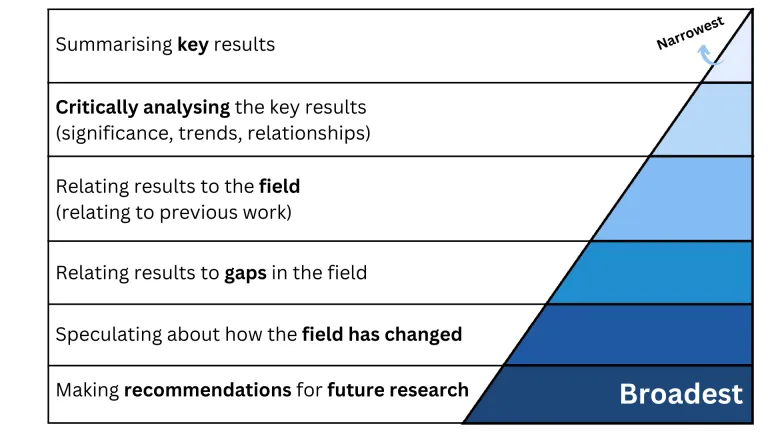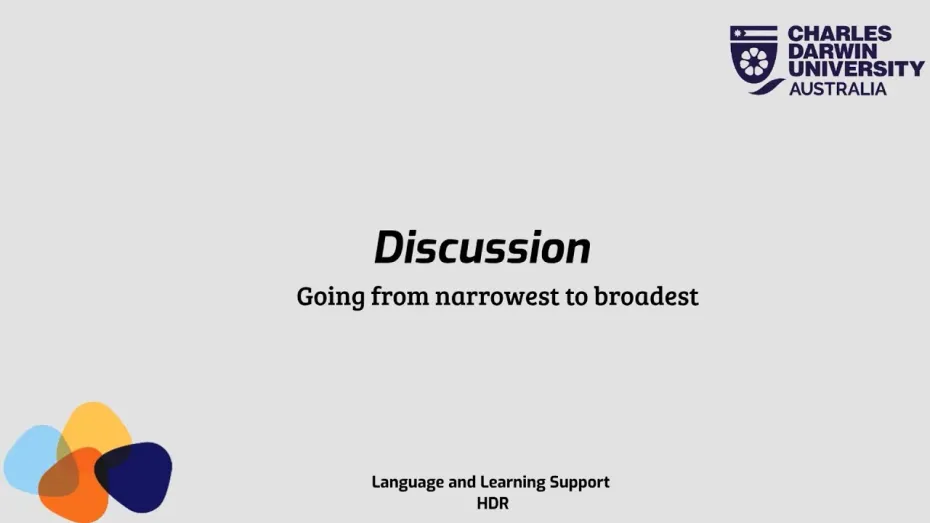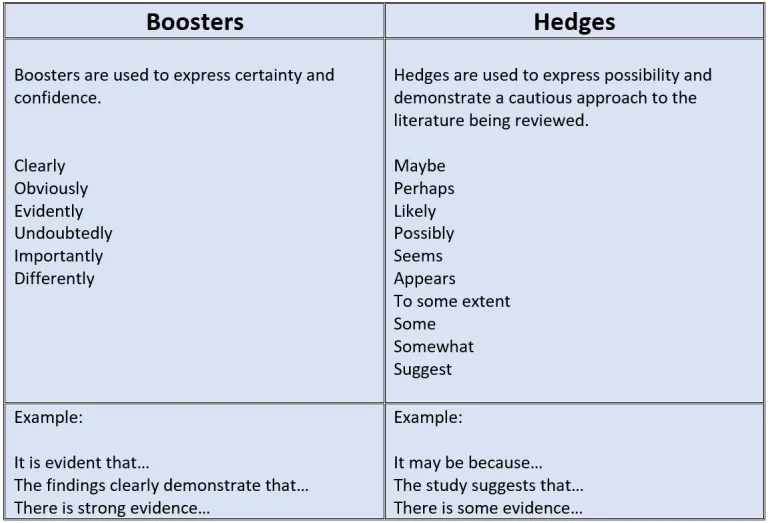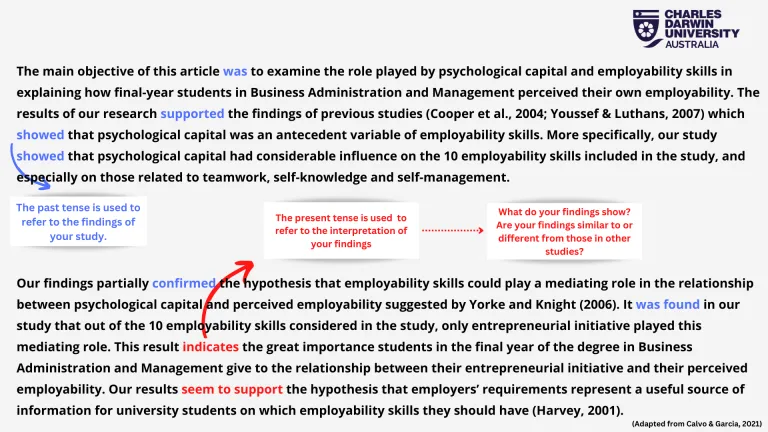In the discussion section, you will draw connections between your findings, existing theory and other research. You will have an opportunity to tell the story arising from your findings.
This page will help you to:
- understand the purpose of the discussion section
- follow the steps required to plan your discussion section
- structure your discussion
- enhance the depth of your discussion
- use appropriate language to discuss your findings.
Download this summary sheet for your own reference.
Introduction to the discussion section
When you have reached this stage, you might be thinking “All I have to do now is to sum up what I have done, and then make a few remarks about what I did” (as cited in Swales & Feak, 2012, p.263). However, writing a discussion section is not that simple. Read on to learn more.
Self evaluation
Before you continue, reflect on your earlier writing experiences and the feedback you have received. How would you rate your ability in the following skills? Rate your ability from ‘good’ to ‘needs development’.
Reflect on your answers. Congratulations if you feel confident about your skills. You may find it helpful to review the materials on this page to confirm your knowledge and possibly learn more. Don't worry if you don't feel confident. Work through these materials to build your skills.
What is in the discussion section?
A discussion critically analyses and interprets the results of a scientific study, placing the results in the context of published literature and explaining how they affect the field.
In this section, you will relate the specific findings of your research to the wider scientific field. This is the opposite of the introduction section, which starts with the broader context and narrows to focus on your specific research topic.
What is the purpose of a discussion section?
The discussion will:
review the findings
put the findings into the context of the overall research
tell readers why the research results are important and where they fit in with the current literature
acknowledge the limitations of the study
make recommendations for future research.
Let's review your understanding of the discussion section by identifying what makes a strong discussion.
Planning for a discussion section
Planning for a discussion section starts with analysing your data. For some kinds of research, the analysis cannot be done until your data has been collected. For others, analysing data can happen early as the data already exists in literary texts, archival documents or similar.
Before starting to write the discussion section, it is important to:
analyse your data (usually reported in the Results or Findings section)
select the key issues that are the substance of your research
relate the findings to the literature and
plan for the process of going from your specific findings to the broader scientific field.
Analysing your results
Your analysis of the results will inform the Findings or Results section of your thesis or publication. It is the stage where you organise and visualise your data, and identify trends, patterns and causal relationships in the themes.
Selecting significant results
As the section discusses the key findings without restating the results, it is important to identify the key issues. For example, you should focus on four or five issues that agree or do not agree with your hypothesis or with previously published work. It is also important to include and discuss any unexpected results.
Relating your results to the literature
You refer to previous research in your discussion section for explaining your results, confirming how your results support the theories and previous studies, comparing your results with similar studies, or showing how your results contradict similar studies.
Therefore, papers that you are likely to refer to in your discussion are those that led to:
your hypothesis
your experimental design
your results.
Moving from narrowest to broadest in your discussion
In writing the discussion section, you will start with your research and then broaden your focus to the field or scientific community. This means you will go from narrowest (your specific findings) to broadest (the wider scientific community). You do this by following the six moves:
As you can see, your discussion may follow six moves (stages) which broadens the scope of your discussion section. Watch this video to learn how to apply these moves.
Structuring your discussion
This section reviews how a discussion section can be organised.
Introduction to structure
A discussion section usually includes five parts or steps, which are illustrated in the image below.
Structuring the discussion section in your journal article
In some disciplines, the researcher's argument determines the structure of the presentation and discussion of findings. In other disciplines, the structure follows established conventions. Therefore, it is important for you to investigate the conventions of your own discipline, by looking at theses in your discipline and articles published in your target journals. The discussion section may be:
in a combined section called Results and Discussion
in a combined section called Discussion and Conclusion
or
in a separate section.
Structuring the discussion section in your thesis
Your discussion section may be an independent chapter or it might be combined with the Findings chapter. Common chapter headings include:
Discussion chapter
Findings and Discussion chapter
Discussion, Recommendations and Conclusion chapter
Discussion and Conclusion chapter
It is important to have a good understanding of the expected content of each chapter. Below is an example of a chapter in which discussion, recommendations and conclusion are combined.
Click on the hotspots to learn more.
Writing a discussion section
This section focuses on useful language for writing your discussion.
Language tip 1: Use boosters and hedges
Boosters and hedges should be used to demonstrate your confidence in your interpretation of the results. They help you to distinguish between clear and strong results and those that you feel less confident about or that may be open to different interpretations.
Read both sentences. Which one shows more confidence in the results?
The Dutch supervisors reported using different types of questions more frequently and deliberately than the Chinese supervisors. This difference may have its roots in the underlying educational philosophies. (Adapted from Hu, Rijst, Veen, & Verloop, 2016)
The findings clearly demonstrate that psychological capital had considerable influence on the 10 employability skills included in the study, and especially on those related to teamwork, self-knowledge and self-management (Adapted from Harper, Bregta & Rundle, 2021)
The writers of sentence two are more confident in the interpretation of their results.
Test your knowledge of hedges and boosters by doing the task below.
Language tip 2: Differentiate your research
It is important to make it clear in your discussion:
which research has been done by you
which research has been done by other people
how they complement each other.
Image 2: Note that present perfect is also used to refer to other studies when you want to emphasise that an area of research is still current and ongoing. Take a look at the example below which uses present perfect to refer to other studies
Like other studies (e.g., Larcombe et al., 2021; Naylor, 2020) that have shown a strong connection between course experience and wellbeing, our study shows that a significant portion of international students believe that aspects of their immediate environment could be improved to better support their wellbeing.
More information on tenses in the Discussion section is presented in Language Tip 4 below.
Language tip 3: Use discussion phrases
Below are some useful discussion phrases that were adapted from Paltridge & Starfield (2020) and the APA Discussion phrases guide (7th edition).
You can download this APA discussion phrase guide here and visit the Academic Phrasebank for further phrases and examples.
Let's look at these extracts and identify the functions of the paragraphs.
Language tip 4: Use the right tenses
Past, present and present perfect tenses are commonly used in the discussion section.
- Past tense is used to summarise the key findings and to refer to the work of previous researchers
- Present perfect is used to refer to the work of previous researchers (usually an area of research that is current and on-going rather than one single study)
- Present tense is used to interpret the results or describe the significance of the findings
- Future is used to make recommendations for further research or providing future direction
Below is an example of some paragraphs in a discussion section in which different tenses are used.
Test your knowledge of using the right tenses in the discussion section by doing the task below.
Working on your discussion section
Use this template to plan your discussion.
The template is an example of a planning tool that will help you develop an overview of the key content that you are going to include in your section. You can download the draft and save it as a Word document once you have finished.
You may have more or less than 3 key findings that you would like to discuss in your section.
Reflect on your learning
1 | Revisit the self-analysis quiz at the top of the page. How would you rate your skills now?
|
2 | Remember that writing is a process and mistakes aren't a bad thing. They are a normal part of learning and can help you to improve. |
If you would like more support, visit the Language and Learning Advisors page.
References
Butler, K. (2020, 7 April). Breakdown of an ideal discussion of scientific research paper. Scientific Communications. https://butlerscicomm.com/breakdown-of-ideal-discussion-section-research-paper
Calvo, J. C. A & García, G. M. (2021). The influence of psychological capital on graduates’ perception of employability: the mediating role of employability skills. Higher Education Research & Development, 40(2), 293-308, DOI: 10.1080/07294360.2020.1738350
Cenamor, J. (2022) To teach or not to teach? Junior academics and the teaching-research relationship. Higher Education Research & Development, 41(5), 1417-1435. DOI: 10.1080/07294360.2021.1933395
Harper, R., Bretag, T & Rundle, K. (2021) Detecting contract cheating: examining the role of assessment type. Higher Education Research & Development, 40(2), 263-278, DOI: 10.1080/07294360.2020.1724899
Hu, Y., Rijst, R. M., Veen, K & N Verloop, N. (2016) The purposes and processes of master's thesis supervision: a comparison of Chinese and Dutch supervisors. Higher Education Research & Development, 35(5), 910-924, DOI: 10.1080/07294360.2016.1139550
Humphrey, P. (2015). English language proficiency in higher education: student conceptualisations and outcomes. [Doctoral dissertation, Griffith University]
Marangell, S., & Baik, C. (2022). International students’ suggestions for what universities can do to better support their mental wellbeing. Journal of International Students, 12(4), 933-954.
Merga, M., & Mason, S. (2021) Early career researchers’ perceptions of the benefits and challenges of sharing research with academic and non-academic end-users, Higher Education Research & Development, 40(7), 1482-1496, DOI: 10.1080/07294360.2020.1815662
Paltridge, B., & Starfield, S. (2019). Thesis and Dissertation Writing in a Second Language: A Handbook for Students and their Supervisors (2nd ed.). Routledge.
Rendle-Short, J. (2009). The Address Term Mate in Australian English: Is it Still a Masculine Term?. Australian Journal of Linguistics, 29(2), 245-268, DOI: 10.1080/07268600902823110
We value your opinion. Please click on the button to share your feedback on these materials. |
Did you know CDU Language and Learning Advisors offer a range of study support options?
https://www.cdu.edu.au/library/language-and-learning-support






